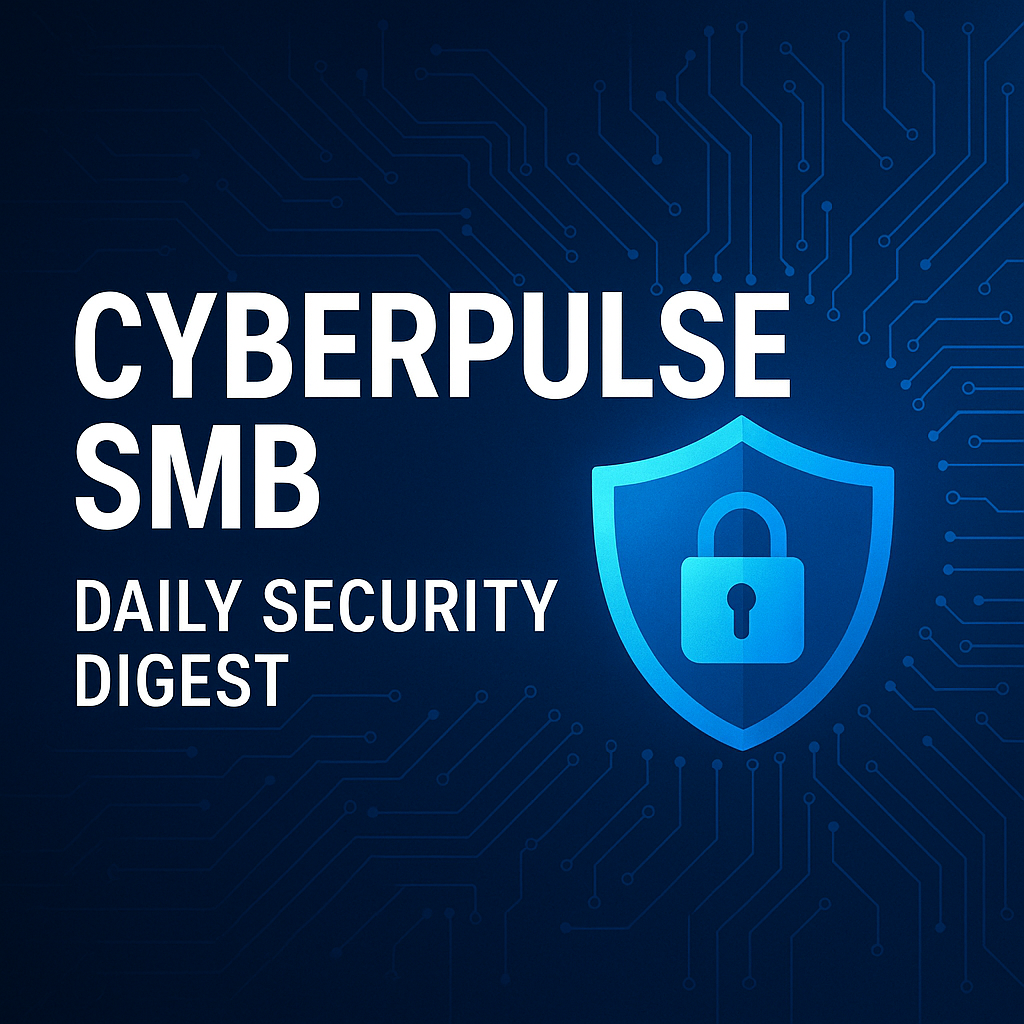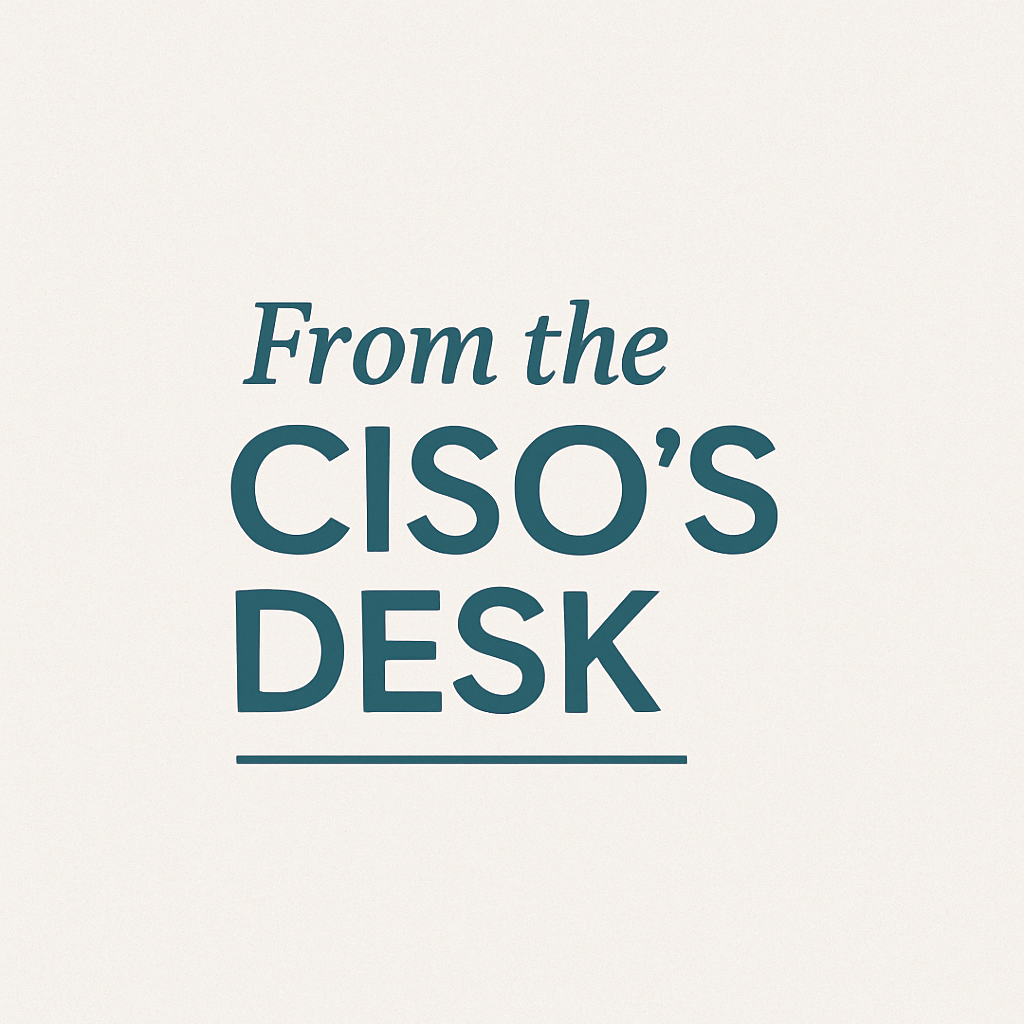🧠 CyberPulse SMB: Daily Security Digest

Date: September 15, 2025
📉 What’s Happening: The Big Picture
Small and mid-sized businesses (SMBs) are no longer flying under the radar. In fact, attackers are now targeting SMBs more frequently than ever—because they often lack the defenses that larger enterprises have in place.
From recent ransomware incidents like the one that hit Lovesac, to compromised developer tools like Salesloft and malicious npm packages, the message is clear:
Cyberattacks are becoming more sophisticated, and SMBs are right in the crosshairs.
🚨 Top Risk Areas — What Business Leaders Need to Know
Here are the key cybersecurity risks you should understand—no technical jargon required.
1. 🧨 Ransomware: Pay Up or Shut Down
Attackers lock your data and demand a ransom to unlock it.
- Risk: You could lose access to operations, customer records, or financial systems.
- Action: Regularly back up your data and train staff on how to spot phishing attempts.
2. ✉️ Phishing & Social Engineering: Tricking Your Team
Fake emails or messages lure employees into giving up passwords or clicking harmful links.
- Risk: One click could compromise your entire business.
- Action: Train your team and require multi-factor authentication (MFA) for all logins.
3. 🔧 Outdated Software: Your Hidden Weakness
Many attacks succeed because businesses don’t apply critical software updates.
- Risk: Hackers exploit known flaws in unpatched systems.
- Action: Set up a consistent patching process for all devices and software.
4. 🌐 Cloud & Remote Access: Weak Points in the Digital Perimeter
Remote work and cloud apps create more access points for attackers.
- Risk: Unauthorized users could access sensitive data remotely.
- Action: Use VPNs, strong passwords, and audit cloud accounts regularly.
5. 🧩 Supply Chain Attacks: Compromised Tools
Hackers inject malicious code into third-party software your team depends on.
- Risk: Even trusted apps can become attack vectors.
- Action: Vet software vendors, monitor for updates, and limit access to critical systems.
6. 🔐 Weak Passwords & Shared Logins
Easy-to-guess passwords and shared accounts are low-hanging fruit for attackers.
- Risk: A single password breach can open the door to your entire system.
- Action: Enforce strong password policies and use password managers.
7. 🧯 No Plan for When Things Go Wrong
Many SMBs have no clear protocol for dealing with an attack.
- Risk: Confusion during a breach leads to longer downtime and bigger costs.
- Action: Create a basic incident response plan. Know who does what.
✅ What You Can Do This Quarter
| ✅ Priority | 📌 Action Item |
|---|---|
| High | Enable multi-factor authentication (MFA) for all accounts |
| High | Set up a patching schedule and automate software updates |
| High | Train employees on phishing and run simulations quarterly |
| Medium | Regularly back up business data, including offline backups |
| Medium | Review third-party software & vendor risks |
| Medium | Enforce strong password rules and use password managers |
| Low | Monitor your network for suspicious behavior (basic tools are fine) |
💬 Final Thoughts
Cybersecurity isn’t just an IT problem—it’s a business continuity issue. It impacts your ability to serve customers, protect your brand, and keep your operations running.
You don’t need to solve everything today, but you do need to start.
Because the cost of doing nothing is often far greater than the cost of getting started.
This blog is part of the “CyberPulse SMB” series—practical security insights for business leaders who wear many hats. Subscribe to get daily threat updates and plain-language tips in your inbox.
🔗 Additional Reading
High-Risk
- https://thehackernews.com/2025/09/6-browser-based-attacks-security-teams.html
- https://thehackernews.com/2025/09/weekly-recap-bootkit-malware-ai-powered.html
- https://thehackernews.com/2025/09/hiddengh0st-winos-and-kkrat-exploit-seo.html
- https://go.theregister.com/feed/www.theregister.com/2025/09/15/north_korea_chatgpt_fake_id/
- https://go.theregister.com/feed/www.theregister.com/2025/09/15/china_nvidia_antitrust/
- https://www.bleepingcomputer.com/news/security/new-voidproxy-phishing-service-targets-microsoft-365-google-accounts/
- https://securelist.com/model-context-protocol-for-ai-integration-abused-in-supply-chain-attacks/117473/
- https://research.checkpoint.com/2025/15th-september-threat-intelligence-report/
- https://thehackernews.com/2025/09/fbi-warns-of-unc6040-and-unc6395.html
- https://thehackernews.com/2025/09/samsung-fixes-critical-zero-day-cve.html
- https://thehackernews.com/2025/09/apple-warns-french-users-of-fourth.html
- https://www.darkreading.com/vulnerabilities-threats/french-sheds-light-apple-spyware-activity
- https://go.theregister.com/feed/www.theregister.com/2025/09/12/hopefully_just_a_poc_hybridpetya/
- https://www.bleepingcomputer.com/news/security/new-hybridpetya-ransomware-can-bypass-uefi-secure-boot/
- https://www.bleepingcomputer.com/news/security/cisa-warns-of-actively-exploited-dassault-rce-vulnerability/
- https://www.bleepingcomputer.com/news/security/the-first-three-things-youll-want-during-a-cyberattack/
- https://www.bitdefender.com/en-us/blog/hotforsecurity/british-rail-passengers-hack-signals-failure
- https://www.schneier.com/blog/archives/2025/09/a-cyberattack-victim-notification-framework.html
- https://unit42.paloaltonetworks.com/third-party-supply-chain-token-management/
- https://www.welivesecurity.com/en/eset-research/introducing-hybridpetya-petya-notpetya-copycat-uefi-secure-boot-bypass/
- https://thehackernews.com/2025/09/new-hybridpetya-ransomware-bypasses.html
- https://thehackernews.com/2025/09/critical-cve-2025-5086-in-delmia-apriso.html
- https://thehackernews.com/2025/09/cloud-native-security-in-2025-why.html
- https://thehackernews.com/2025/09/cursor-ai-code-editor-flaw-enables.html
- https://www.darkreading.com/vulnerabilities-threats/gentlemen-ransomware-vulnerable-driver-security-gear
- https://www.darkreading.com/vulnerabilities-threats/apple-carplay-rce-exploit
- https://www.darkreading.com/cyber-risk/f5-calypsoai-advanced-ai-security-capabilities
- https://krebsonsecurity.com/2025/09/bulletproof-host-stark-industries-evades-eu-sanctions/
- https://www.bleepingcomputer.com/news/security/samsung-patches-actively-exploited-zero-day-reported-by-whatsapp/
- https://www.bleepingcomputer.com/news/security/us-senator-accuses-microsoft-of-gross-cybersecurity-negligence/
- https://www.bleepingcomputer.com/news/security/apple-warns-customers-targeted-in-recent-spyware-attacks/
- https://www.welivesecurity.com/en/business-security/cybercriminals-hacking-systems-logging-in/
- https://research.checkpoint.com/2025/yurei-the-ghost-of-open-source-ransomware/
- https://www.mdpi.com/2075-1702/13/9/847
Policy
- https://go.theregister.com/feed/www.theregister.com/2025/09/15/oracle_spending_shares_opinion/
- https://www.bleepingcomputer.com/news/security/fbi-warns-of-unc6040-unc6395-hackers-stealing-salesforce-data/
- https://www.mdpi.com/1422-0067/26/18/8984
- https://go.theregister.com/feed/www.theregister.com/2025/09/12/fire_up_gas_turbines_ai_race/
- https://openssf.org/blog/2025/09/12/celebrating-the-community-openssf-at-open-source-summit-and-openssf-community-day-europe-recap/
- https://www.mdpi.com/2075-5309/15/18/3321
- https://go.theregister.com/feed/www.theregister.com/2025/09/12/google_cloud_mod_contract/
- https://www.bleepingcomputer.com/news/security/man-gets-over-4-years-in-prison-for-selling-unreleased-movies/
- https://openssf.org/blog/2025/09/11/open-source-friday-with-openssf-global-cyber-policy-working-group/
- https://www.mdpi.com/2075-1729/15/9/1431
Awareness
- https://go.theregister.com/feed/www.theregister.com/2025/09/12/sk_hynix_hbm4_mass_production/
- https://www.schneier.com/blog/archives/2025/09/assessing-the-quality-of-dried-squid.html
Emerging
- https://thehackernews.com/2025/09/ai-powered-villager-pen-testing-tool.html
- https://go.theregister.com/feed/www.theregister.com/2025/09/15/finwise_insider_data_breach/
- https://isc.sans.edu/diary/rss/32284
- https://www.bleepingcomputer.com/news/microsoft/microsoft-says-windows-september-updates-break-smbv1-shares/
- https://www.bleepingcomputer.com/news/microsoft/microsoft-reminds-of-windows-10-support-ending-in-30-days/
- https://www.schneier.com/blog/archives/2025/09/lawsuit-about-whatsapp-security.html
- https://www.schneier.com/blog/archives/2025/09/upcoming-speaking-engagements-48.html
- https://tailscale.com/blog/tailscale-sharing-friends-family
- https://www.mdpi.com/2412-3811/10/9/242
- https://www.mdpi.com/2673-7272/5/3/79
- https://www.mdpi.com/2073-431X/14/9/386
- https://www.mdpi.com/2075-4698/15/9/258
- https://www.darkreading.com/cyberattacks-data-breaches/without-federal-help-cyber-defense-cisa
- https://go.theregister.com/feed/www.theregister.com/2025/09/13/refresh_an_old_mac/
- https://go.theregister.com/feed/www.theregister.com/2025/09/13/to_make_a_humanoid_robot/
- https://www.bleepingcomputer.com/news/microsoft/windows-11-23h2-home-and-pro-reach-end-of-support-in-60-days/
- https://thehackernews.com/2025/09/google-pixel-10-adds-c2pa-support-to.html
- https://www.darkreading.com/cyberattacks-data-breaches/vyro-ai-leak-cyber-hygiene
- https://go.theregister.com/feed/www.theregister.com/2025/09/12/china_polysilicon_monopoly/
- https://go.theregister.com/feed/www.theregister.com/2025/09/12/nasa_science_gets_a_boost/
- https://go.theregister.com/feed/www.theregister.com/2025/09/12/opensuse_to_drop_bcachefs_support/
- https://go.theregister.com/feed/www.theregister.com/2025/09/12/eu_regulators_let_microsoft_off/
- https://isc.sans.edu/diary/rss/32280
- https://www.bleepingcomputer.com/news/microsoft/microsoft-investigates-exchange-online-outage-in-north-america/
- https://www.mdpi.com/2075-1729/15/9/1433
- https://www.mdpi.com/2075-1680/14/9/695
Controls
Other
- https://go.theregister.com/feed/www.theregister.com/2025/09/15/starlink_outage/
- https://www.bleepingcomputer.com/news/microsoft/microsoft-fixes-windows-11-audio-issues-confirmed-in-december/
- https://go.theregister.com/feed/www.theregister.com/2025/09/14/destroy_data_company_laptops_or_else/
- https://go.theregister.com/feed/www.theregister.com/2025/09/14/galaxy_fold7_foldable_smartphones_rising/
- https://www.mdpi.com/1422-0067/26/18/8953
- https://www.darkreading.com/ics-ot-security/undocumented-radios-found-solar-powered-devices
📥 Subscribe or Contribute
Join the CyberPulse email digest or email morgan@sprico.com to submit an article or recommendation.
